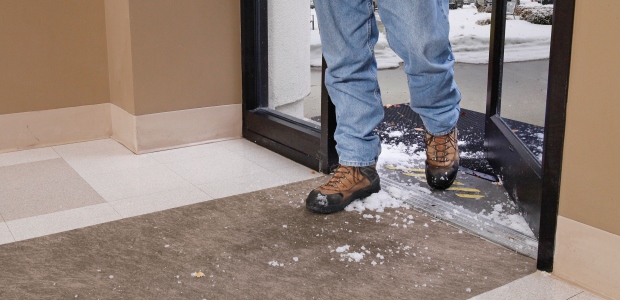
Preventative Maintenance Tasks That Help Prevent Slips, Trips, and Falls
Most of these preventative maintenance techniques can be rolled into routine good housekeeping plans. Others can be incorporated into regular and periodic safety inspections.
- By Karen D. Hamel
- Jul 01, 2018
Scheduling fluid changes, routinely replacing hoses and pipes to prevent failure, and regularly checking monitors and gauges are just a few of the preventative maintenance tasks that are consistently performed at many facilities to help prevent essential equipment from breaking down. Each facility has its own strategy for how and why preventative maintenance functions are undertaken, but one of the main reasons for preventive maintenance is simple: to avoid unplanned downtime and keep things running smoothly and safely.
Preventative maintenance schedules also can be applied to procedures that help prevent slip, trip, and fall injuries. Just as unexpected downtime caused by a broken machine disrupts production schedules, unexpected slip, trip, and fall hazards cause lost worktime injuries that impact facility operations. Establishing preventative maintenance schedules to routinely identify and eliminate walking-working surface hazards will help prevent this very common cause of employee injuries and their associated costs.
Stroll Through Parking Lots
Freeze-thaw cycles, traffic, and tree roots are few of the causes of potholes, deep cracks, and uneven surfaces in parking lots and on sidewalks. Left unchecked, they present trip and fall hazards for employees entering and exiting the facility.
At a minimum, all outdoor sidewalks, walking paths, decks, and parking lots should be inspected with the change of each season to make sure that no surface imperfections have developed. When imperfections are found, identifying them with traffic cones or barricades until they can be repaired will help prevent injuries. These inspections are also a good time to make sure that outdoor lighting is functional and adequate in all outdoor areas.
Maintain Mops, Fans, Shovels and Snowmelt
Rain, snow, and ice can cause indoor and outdoor walking surfaces to become slippery. Controlling inclement weather isn’t possible, but being prepared for it is. Like stocking fuses, bolts, and hoses; keeping shovels, snow melt, mops, buckets, floor fans, extra entrance matting, or any other items that are routinely used to clear walkways and keep floors clean and dry in stock and ready for use will reduce the chance of injuries in these areas.
Schedule maintenance for snow removal equipment in the summer or early fall before it will be needed. Service other routinely used maintenance equipment regularly so that it is always ready. Inventory mops and shovels semi-annually to make sure that there are an adequate number available. Consider improvement such as canopies over entrances to limit the amount of rain or snow that enters the building and absorbent entrance matting to keep entrances and lobbies cleaner and drier.
Check Roofs and Ceilings
Because gravity is a law of nature, leaks from roofs will eventually end up on the floor, creating a slippery puddle. Likewise, leaks and condensation from pipes that are concealed above ceiling tiles will also eventually drip. Evaluating these areas at least annually—or more often in areas where tornadoes and hurricanes are common—can identify the need for repairs.
The buckets, cans, and pails used to collect roof and ceiling leaks and drips can also cause problems. If the collection containers are small, they may not be seen, causing a trip hazard. If they are not emptied regularly, they can cause odor and indoor air quality problems.
If timely repairs cannot be made before or immediately after leaks occur, stocking wet floor signs, barricades, roof leak diverting tarps, and quick repair kits can temporarily fix or guard these hazards until full repairs can be made.
Plan for Leaks, Drips and Spills
Leaks and spills can happen anywhere liquids are present. Production areas, warehouses, loading docks, waste collection rooms, fluid dispensing stations, cafeterias, and bathrooms are all examples.
Keeping stocked spill kits in each of these areas allows employees to quickly respond to larger spills. But a common problem is that employees will use the absorbents and tools stocked in the spill kits for daily use. Using tamper-evident seals on the containers used to store spill response items can serve as a reminder that these items are to be reserved for spills. They also facilitate routine inspections by providing a quick indication of whether or not the container needs to be checked and restocked.
To keep employees from using spill kit contents, stock wipes, absorbent mats and socks, squeegees, mops, and other items in the areas where leaks, drips, spills, and overspray are likely to occur so that everyone has ready access to these daily-use items they need to keep floors clean and dry. This also helps to prevent people from leaving the mess for someone else because it is not convenient to go gather the necessary tools to clean it up.
Make Trash and Recycling Receptacles Available
If finding a trash can or recycling bin takes time, or they aren't readily available, employees may be more likely to let clutter and waste accumulate on floors or in aisles. This can create slip, trip, and fall hazards throughout the facility. Dedicating space for waste cans and recycling bins in each work area and ensuring that they are adequately sized can help avoid this.
Most of these preventative maintenance techniques can be rolled into routine good housekeeping plans. Others can be incorporated into regular and periodic safety inspections. Scheduling these best practices will help prevent painful and costly slip, trip, and fall injuries.
This article originally appeared in the July 2018 issue of Occupational Health & Safety.